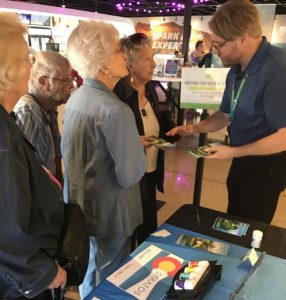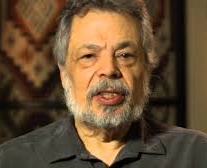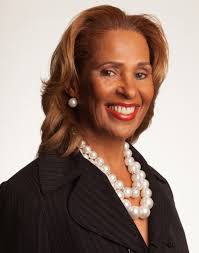Sara Davidson
|April, 20, 2018
On a sunny afternoon last August, a dozen women from Balfour Senior Living in Louisville, CO, boarded a bus for a field trip to a marijuana dispensary. One used a walker, one was hooked up to an oxygen tank, one wore a linen suit and jewelry, and all were told to wear hats while walking from the bus to the dispensary door. “The sun is our enemy,” one said.
Joan Stammerjohn, 84, said she’d joined the group because she’s had chronic pain in her legs and has been taking Oxycontin for ten years.
“I’d like to get off it,” she said. Others said they had ailments like arthritis or back pain, but didn’t want to disclose their names because they believe marijuana is still stigmatized. “We’re traveling incognito,” one said, adding, “I’m excited. I came to open my mind—I want to know the latest things. I hope this won’t be in the paper, though. We’ll have a crowd coming to Balfour, thinking this is the coolest place.”
Filing inside the Ajoya dispensary, they were overwhelmed by the display cases filled with jars of green flower clumps, pills, tinctures, edibles ranging from chocolates to gummy bears, vape pens, oils, patches and creams.

A rep from Stratos cannabis
explains products to seniors
As they listened to budtenders recommend what to use for pain, arthritis, or sleep, a 92-year-old bowed her head and slowly, slowly, started slumping against the counter. “Are you all right?” I asked. She fainted to the floor. A staff member knelt beside her as she regained consciousness. Paramedics arrived, but a half hour later, the woman, smiling, walked out the door with $120 worth of products.
Seniors are the fastest growing population of new cannabis users. Ten thousand people are turning 65 each day, according to the Pew Research Center, and many are trying cannabis—now the preferred word for marijuana—for health and well-being.
The week before the field trip, there’d been a lecture at Balfour by Joseph Cohen, D.O., founder of Holos Health, which advises people on medical cannabis. His lecture, sponsored by the Stratos cannabis company, drew an overflow crowd of 200, standing against walls and spilling into the hallway.
“The first thing older folks say when they enter our office is, ‘I don’t want to get high,’” Cohen said. He explained that there are two primary compounds in cannabis: THC, which is psychoactive, and CBD, which is not. “So CBD is a great solution for elders,” he said. “I took a little CBD before this talk, to make sure I stay calm.”

humans—the gold standard in medical science. Because cannabis is federally illegal, it’s nearly impossible to conduct such studies. Most assertions are based on anecdotes, observations, and experiments with animals and human cells.
In February, however, a peer-reviewed study of almost 3000 patients in Israel—the first of its kind—showed that cannabis can be safe and effective for seniors, and lead to decreased use of pharmaceuticals, including opioids. In the study, published in the European Journal of Internal Medicine, almost 94% of patients reported improvement in their condition, and their pain level was reduced by half.
Cohen, who practiced obstetrics and gynecology for 30 years, informed the group about the endocannabinoid system, discovered in 1988, which regulates many body processes, including nerve signaling, reproduction, and the immune system. “When I went to medical school, we didn’t know about the endocannabinoid system,” Cohen said. “We knew about THC because we’d light up between classes.”
People laughed, and he continued, “We’re wired for this plant.” He explained that the body makes endocannabinoids, chemicals similar to THC and CBD, which lock onto cannabinoid receptors found throughout the body, especially in the brain. Raphael Mechoulam, the Israeli biochemist who discovered THC in 1964, says, “Receptors are not found in the body because there is a plant out there that will trigger them. Receptors are present because the body makes compounds that activate them.” Whether by coincidence or grand design, the THC and CBD found in the marijuana plant mimic the endocannabinoids made by the body.
It’s significant, Cohen said, that there are no cannabinoid receptors in the brain stem, which monitors heart rate and breathing. “That’s why you can’t overdose and die from cannabis. It won’t stop your breathing, which an overdose of opioids can do.”
People in the audience seemed intrigued. Diane Arnold, 75, said, “I’d love to use it for my dog. She was put on steroids that nearly killed her.”
Two major groups of seniors are turning to cannabis. The first, like the women on the field trip, never tried marijuana and are drawn to its alleged health benefits.
The second are boomers who “smoked dope” in the Sixties and Seventies, giving it up when they became focused on careers and raising kids. An attorney I know in L.A. experimented with drugs when a student at Stanford. “I was interested in the impact of psychedelics on creativity and spirituality,” he said. But his law practice required intense concentration, and his wife worked for a company that did random drug testing. They switched from cannabis to wine, became collectors, and when they divorced, custody of their wine cellar was a major point of contention.
At 71, the attorney, who doesn’t want his name disclosed, developed acute pain in his joints and was diagnosed with Polymyalgia rheumatica, an inflammatory auto-immune disease. His doctor put him on prednisone, which decreased the pain but had unpleasant side effects, including insomnia, and required him to give up wine.
When he began hearing that CBD was anti-inflammatory, he secured a medical license and went to a dispensary. “I was shocked,” he said. “The last time I was smoking grass, you bought a baggie filled with sticks and seeds from some shady character. You took whatever he had.”
At the dispensary, he saw products labeled with the names of the strains and percentages of THC and CBD they contained. “The 20-something budtenders became my sommeliers,” he said. “They’re as knowledgeable as wine stewards at the best L.A. restaurants.” He found a strain, Bubba Kush, that helped him sleep, and started branching out, enjoying other effects.
Another boomer who’s having a second go at cannabis is a former high school teacher in Boulder, who wanted to try CBD for anxiety. Two years ago, she couldn’t find plants with a high concentration of CBD. Colorado growers had been breeding marijuana to increase THC and reduce CBD. The only CBD she found in concentrated amounts was in oil made from hemp.
Hemp and marijuana belong to the same genus, cannabis. But hemp is defined, for legal purposes, as containing less that .3% THC. Because it has only a trace of THC, hemp oil is legal federally and can be purchased online. But the teacher wanted CBD from the whole marijuana plant. Many who study cannabis assert that the chemicals—more than 400—in the plant work together to create an “entourage effect,” which makes whole plant products more potent than oil containing CBD only.
The teacher called her daughter in Seattle, who clandestinely brought her plants with higher amounts of CBD than she could find in Colorado. She started making her own oil from the plant. Her kitchen looked like a scene from

One group of seniors who’ve been resistant to medical cannabis is African-Americans. Sue Taylor, 70, a retired Catholic school principal, said that for many in her Oakland community, “It’s a hardcore drug that got their young men in jail.” As a commissioner on aging in Alameda County, she speaks to African-Americans at churches and senior centers. “They sit, frowning, with their arms folded across their chests,” she said. “I tell them I’m not trying to convince anyone, I just want to let you know about the health benefits.”

Sue Taylor
She plans to open iCANN Berkeley, a dispensary and wellness center in a traditionally black neighborhood, this summer. It will cater to seniors, whom she considers “the most vulnerable population we have. People think they can give them a pill and not worry if it’s gonna kill them because they’re almost dead anyway,” she said.
Taylor herself never smoked pot while raising her three sons, and told them, “If I ever find it in the house, I will call the police.” She was living in Atlanta after retiring when one of her sons called and said he was studying at Oaksterdam University, a school for the cannabis industry. She flew home to “save him from drugs.”
She listened to him, though, and did research. She went to senior care homes where staff told her about patients who used to cry and scream at night but became calm with medical cannabis. She worked at Harborside dispensary, and saw patients improve after cannabis treatment.
Taylor became a cannabis activist for seniors. “Our biggest problem is multiple drugs,” she said. “Most seniors we see are taking 15 to 26 pills a day.” She explained that to start, they might consult a doctor for high blood pressure. “The doctor gives them a pill for it, which causes the thyroid to go out. The thyroid pill causes the liver to go out. The liver pill makes your pancreas go out of whack, and the list goes on. Most important,” she said, “the patients are not getting better. They’re getting worse and worse.”
She advises people not to quit all pharmaceuticals at once, but to cut down gradually with a doctor’s supervision. If they don’t have a doctor to guide them, she refers them to one.
Six months after the Balfour lecture and field trip, I contacted some of the participants to see how they’d fared. Leslie Brown, who suffers from insomnia, said she tried one pill. “I gave it a shot and it didn’t help me sleep, so I didn’t take any more.” Her husband, Ira, who has neuropathy, said he tried a gummi bear two times and “it had no effect.”
When I reported this to Dr. Cohen, he said, “People have to realize that sometimes you have to wake up your receptors. You have to try it several times. And not everything works for everybody, anyway.”
When I told this to Leslie, she was silent. “Maybe I’ll try it again,” she said. “It would be nice to have a good night’s sleep.”
Hi Sara
I am a senior and former pothead who has been trying cannabis for two things: neuropathy and insomnia. (I obtained a medical marijuana card because I live in Washington DC.) Unfortunately, I have not received much guidance from the dispensary. I am trying two tinctures. At first I took both at once because I thought that is what I was told to do. I just got very dizzy. Then I tried one which, it turned out kept me awake (Maybe because it is called “awake” LOL). I called the dispensary and was advised to take the other (Blue Cheese) for insomnia. And so far it seems to work. I am sleeping pretty well. I tried Awake before bedtime and the tingling in the legs seemed to subside, but the jury is still out. I will try to get better advice from the dispensary.
Hi Terri, The budtenders at a dispensary are not the best source of advice. I recommend consulting a cannabis physician. A doctor who has researched and is practicing “dosed dispensing,” i.e. advising you how much to take of what. I know of two I would trust, Dustin Sulak, D.O., in Maine, and Allan Frankel, M.D., in Santa Monica, CA. They may be able to recommend someone in the D.C. area, or you could have a phone/skype consultation. Then, the problem is getting the products with the dosage they recommend. Bottom line: it’s trial and error, until it’s legalized, there can be adequate testing and cross-state purchasing, etc. Send you many warm regards and wishes for healing.
Hey if it works, do more of it. At one time I had a job where I guided people towards helpful care with the goal of getting better. I soon learned that if people believed the treatment would work, then it more often that not worked! In my Junior high years I smoked marijuana a couple of times but I really did not care for some of the Losers that I mixed with while doing marijuana, but if works for some folks then I am OK with them using, not that they would need my approval in any event. Jim
Hi Sara Dear, as always and with a healthy par usual, you’ve written another timely piece that pierced our perception, awakening mind and heart…!!
Love you,
~Mamie
Hi Sara,
It’s Marilyn, here in Honolulu.
I really enjoyed this article. And isn’t it funny how the stars align? I have been having trouble sleeping, the doctor recommended melatonin ( Yep that’s all) and then two different friends at different times mentioned CBD. So I have been trying it, and it does seem to help. Also, on line, I got CBD biscuits for my old dog who creaks around. He seems perkier too.
Good information on having to try different varieties. I got my CBD from Down to Earth, so will see if there is a dispensary around. It would be great to find a chef for CBD.
Sara,
Another one of your informative, detailed and well written articles. Please keep them coming!
Great article and very timely for baby boomers…especially here inColorado.
Thank you Sara!
Sara – Thank you sooo much! I have taken the liberty of forwarding to at least 50 friends, including my SS class (30) where the avg age is 79. The subject has come up at least three times in the last six months. I live in a 55+ Apt complex, and I know some are using, probably many more, and say it has helped. I signed a petition to put on Mo ballot in the fall, and will be voting yes.
This is so exciting. But seems difficult to obtain for the average person. Unless I go to Colorado, I don’t think I could get some to try. ???
Two comments:
You can never discount the placebo effect of any medication. So there really is no true information when you look at the medical literature.
The elderly and those who used marijuana decades ago have to be extremely careful because what is sold today is much stronger and puts people at risk for overdose and significant side effects.